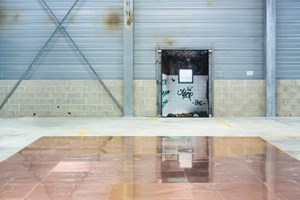
As COVID-19 continues its devastating spread across Europe, ArtDependence has reached out to Galleria Continua in Italy. We wanted to shine a light on the work of the artists in the country and to create a showcase for their art. As galleries and art fairs continue to announce on-going closures and cancellations, we wanted to hear what life is like for artists living under the threat of the invisible enemy.
Image: Sin Tiempo, exhibition views, Galleria Continua, Les Moulins, 2019, Courtesy: the artist and GALLERIA CONTINUA, Photo by: Oak Taylor-Smith
Exhibition: Sin Tiempo, Year and place: 2019 / Galleria Continua, Les Moulins
As COVID-19 continues its devastating spread across Europe, ArtDependence has reached out to Galleria Continua in Italy. We wanted to shine a light on the work of the artists in the country and to create a showcase for their art. As galleries and art fairs continue to announce on-going closures and cancellations, we wanted to hear what life is like for artists living under the threat of the invisible enemy.
Serse
ArtDependence (AD): Does the art world have a role to play at this pivotal moment in history?
Serse: I am sceptical of the doctrine that art plays an important role in real life today. Art is above all an exercise in the imagination. It makes us participate, but it expresses itself in the form of aesthetic fiction. I, as an artist, feel I live in the realm of this ambiguity; in the continuous oscillation between real experience and vicarious experience. It is the double root of Art, and from here I see our impotence.
AD: What are you working on at the moment?
Serse: Drawing water surfaces. I look for the awareness of not seeing anything clearly and how much the eye is actually able to discriminate the shape of objects: "No footprint is clear, but no shape remains unknown," John Ruskin.
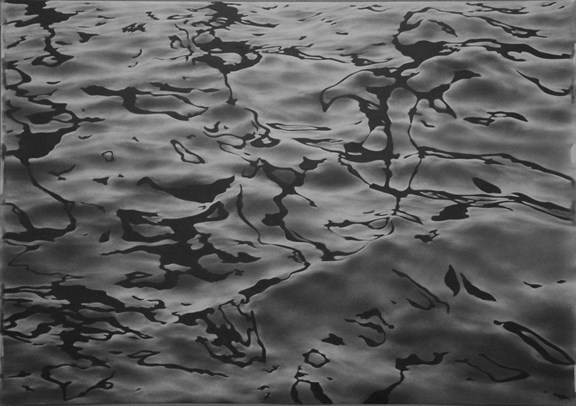
A fior d'acqua, 2016 graphite on paper on aluminum 100 x 142 cm, Courtesy: the artist and GALLERIA CONTINUA

Canneti 2016, graphite on paper on aluminum 100 x 142 cm, Courtesy: the artist and GALLERIA CONTINUA
AD: Has your work been impacted by the coronavirus?
Serse: As in the ancient legend of Narciso and Eco: the nymph loves Narciso, but he, being in love with his reflected image, did not want to see anything but his own face. Eco could only repeat the last two words heard: virus, virus…virus, virus. I believe that conversing with Eco does not give much satisfaction.
AD: Can you name a contemporary Italian artist who inspires you?
Serse: Giuseppe Penone. His work Reverse Eyeshas been fundamental for my reflections on the sensitivity of the gaze.
AD: When did you first begin to think of yourself as an artist?
Serse: In the 70s, in the long gallery of interests of a young student where everything had lost its sting, modern art began to scream. If art raised its voice it was because I was starting to become deaf. Thus began the visits to the Venice Biennale, the reading of Eupalinos or the architect of Paul Valéry. Luigi Nono's music and Coleman's free jazz did the rest.
Sabrina Mezzaqui
Thank you for the questions. I usually take questions as a kind of food for thought.
To the questions about these days, I can only answer that I don't know. I don't know the role of the art world now. I don't know how the virus affects my work. I'm working on copying Hannah Arendt's notebooks. Lately I have felt inspired by the work of Maria Lai: her notebooks sewn full of secrets, and the ability to weave community in Ulassai, her country.
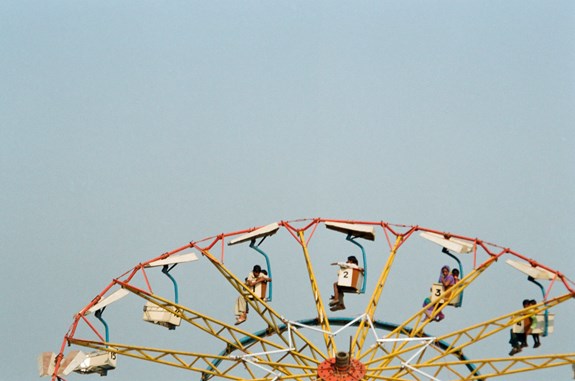
Vestiti di cielo, 2008, lightbox 50 x 70 cm, Courtesy: GALLERIA CONTINUA
I don't know when I started to perceive myself as an artist, I don't seem to know anything else. I have no prophetic visions, I don't know what will happen. I try not to let myself be overwhelmed by fear. Every single day has its own special intensity. I try to breathe deeply. And not to lose contact with the natural world, now so bright and all in bloom.
Giovanni Ozzola
AD: Does the art world have a role to play at this pivotal moment in history?
Giovanni Ozzola (GO): More than ever, this is the moment where Art in all of its own forms has a key role.
As I always say, reality seen through any form of art becomes a poem. It is much easier to fully understand or accept a poem. You only have to perceive it. The truth gets under your skin, skipping all the barriers, skipping all the filters that we apply when we formally try to understand what is happening to us. It reaches you deeply inside, and starts to work on you, from the inside out.
AD: What are you working on at the moment?
GO: On me, facing all my weaknesses and trying to understand my points of strength, as a human being and as an artist.
I owe everything to Art. Until a few weeks ago, I was one of those constantly traveling around the globe. I know airports and their shops and bookstores, where to eat etc.

Kitchen 2.13 am, 2017-2018 giclée print on cotton paper, Dibond, black framed 102 x 153 cm, Courtesy: the artist and GALLERIA CONTINUA Photo by: the artist
I look back at myself from my current perspective and I'm amazed to see what I was considering to be normal.
Now I’m at home, with my family, with my children. I can't go to my studio, so I'm working at home. It’s a completely different attitude. It’s very interesting. Not easy, but extremely interesting.
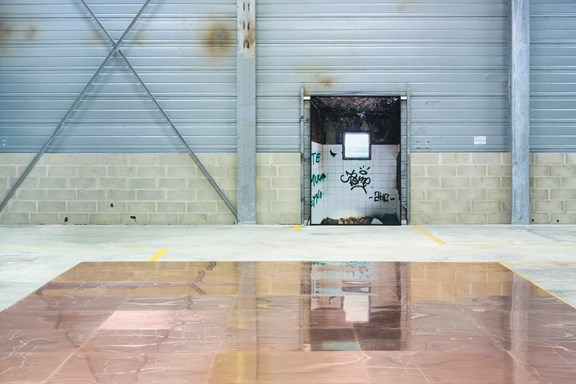
Sin Tiempo, exhibition views, Galleria Continua, Les Moulins, 2019, Courtesy: the artist and GALLERIA CONTINUA, Photo by: Oak Taylor-Smith
Exhibition: Sin Tiempo, Year and place: 2019 / Galleria Continua, Les Moulins
There is almost no time for myself, I’m used to being alone a lot - alone at the studio, alone while traveling. Now I travel in a different way. Living on an island at night, I have the chance to go on my terrace and look at planets through a little telescope that I have. I also try to spot the ISS, those groups of persons traveling in orbit around the Earth. It is quite a romantic image in these days.
AD: Has your work been impacted by the coronavirus?
GO: Deeply and in every way. Every single project has been postponed. Working a lot in Asia, since January I've experienced the effect of the virus spreading. At the same time, I’ve seen a rise in requests for collaborations, interviews and different kinds of projects. There is a massive need for content with some sort of depth. We are understanding that we have no time for superficiality. I think people need to understand, to feel part of something bigger, to feel understood.
AD: Can you name a contemporary Italian artist who inspires you?
GO: I have no idols, I appreciate the dedication, the hard-work and the knowledge of many artists. Being strict to yourself, to your method. Day after day, building and following your own religion. It’s a real discipline. I’m amused by recognizing that kind of energy in a person.
Having said that, I love immensely many different artworks like: Eos (L’Aurora) by Luciano Fabro, or Giovanni Anselmo’s Grigi che si alleggeriscono verso oltremare. These titles are poems already.
AD: When did you first begin to think of yourself as an artist?
GO: I was 18 years old, didn’t know what to do with myself, I was quite nomadic since I had left home a couple of years before.
While in London, thanks to a common friend, I met Pier Luigi Tazzi. Then I travelled between Amsterdam and Brussels and met Irene Fortuyn and Jan Vercruysse. I met again with Pierluigi and I found myself showing him the photos I was taking during that period. After a long conversation (very maieutic), he wrote a text about my work, about me. He managed to show me who I was and what I was doing. Yes, I faced who I was through a text. I still keep it. Just in case.
Loris Cecchini
AD: Does the art world have a role to play at this pivotal moment in history?
Loris Cecchini (LC): The world of art can be supportive throughout the whole system. In Italy there have been many proposals for auctions in which the works are offered for sale and the proceeds are donated to hospitals and public structures to bear even the minimum costs for the necessary materials. It’s true that international stock exchanges are in great crisis and this can create reticence for collectors to buy, but the motivations for purchasing a work in these circumstances are also motivated by collective humanitarian reasons. Personally, I’ve always been available to donate works as a form of financial support, what is often missing is documentation that records the artist's donation in tax terms, which would seem legitimate and appropriate. I would also be happy to see a massive cultural contribution proposed by national broadcasting channels. That would be great educational content for the broad public in these months of isolation.
AD: What are you working on at the moment?
LC: I continue to work on designing 3d sculpture projects and installations, but I also spend a lot of time on manual drawing and small sculptures that I had left aside in the studio. What has really changed from before is a long time when deadlines are absent. Greater tranquillity, greater reflection, maximum economy of means. And why not - even a little more sensitivity.
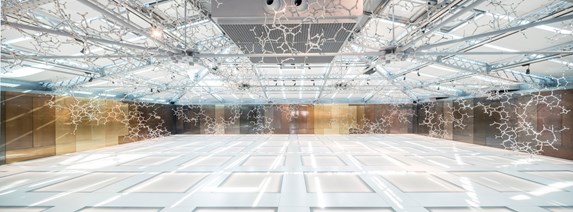
Loris Cecchini, Waterbones , 2017
steel elements, Courtesy: the artist and GALLERIA CONTINUA, Photo by: Matteo De Fina, Photo caption: installation view Fondaco dei Tedeschi, Venezia, 2017
AD: Has your work been impacted by the coronavirus?
LC: I have many production relationships outside the studio. Various suppliers, artisans, companies, all of them are on compulsory standby; my productions of steel elements have been stopped for weeks. All projects, national and international, are stopped. Even if we continue to work on paper to continue a previous project, we are waiting for more operational times. It is a situation where the work of art becomes a more private and personal practice, waiting for a public horizon that will surely return. Personally I have always thought of a part of my work as a viral metaphor and as a connection paradigm. In addition, there is a role of Nature that returns in a domineering way, recovering its physical space, beyond the conceptual confinement to which we have relegated it.
AD: Can you name a contemporary Italian artist who inspires you?
LC: There are at least 3 generations of artists that I continue to observe and appreciate, despite the different positions and language. Good works produce their own system.
AD: When did you first begin to think of yourself as an artist?
LC: I was lucky, I wanted to work and be an artist since I was 15 years old. I have never stopped working.
Ornaghi & Prestinari
AD: Does the art world have a role to play at this pivotal moment in history?
O&P: We realize how the works of art, by virtue of their polysemy and of being always contemporary, can be re-read at any time in the light of the experiences that are being experienced or lived.
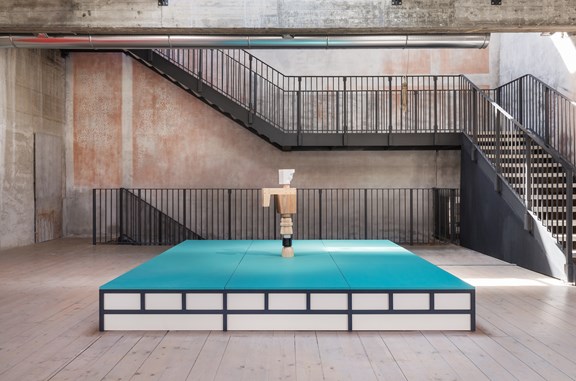
Cionco, 2019 painted wood, steel, motor, electronic control unit 300 x 300 x 160 cm, Courtesy: the artist and GALLERIA CONTINUA, Photo by: Melania Dalle Grave e Agnese Bedini, DSL Studio
Art and culture have an indisputable social value and it is rediscovered even in a critical moment like this when thanks to the works we can draw lessons, we can rework emotions or empathically tune in with the mystery of an image.
AD: What are you working on at the moment?
O&P: At the moment we are carrying out work for exhibitions that we already had in the program. All events have been postponed but not cancelled.
AD: Has your work been impacted by the coronavirus?
O&P: It is too early to say. Each experience needs its time to be reworked. As far as the way we work is concerned, there have been no major changes. Our home-studio is located in Rho (Milan) and is inside a typical Lombard courtyard house. Outside we have a small equipped laboratory that overlooks a small garden and an underground space for the dirtiest processes. On the upper floor of our house, however, we have created a study to think and design.
We have always spent most of our time among these spaces spread over several levels. Coronavirus has certainly impacted on the possibility of participating in exhibitions, residences and various types of events. The whole art system is at a standstill and is focusing on the promotion of digital content that is accessible from home.
AD: Can you name a contemporary Italian artist who inspires you?
O&P: In our research there is always a strong relationship with the history of art, especially Italian art. Consequently we often deal with the work of other artists who are important to us. We are interested in retransmitting a signal that we perceive within a work and that we rework or distort through our way of feeling to carry on a speech that does not begin and end with us.
AD: When did you first begin to think of yourself as an artist?
O&P: We are professional artists in the sense that we are part of a system whereby what we do is called art. Regardless of the labels, we are interested in investigating the human condition and we do it through visual language.

Prove di volo, 2018 ceramic, fabric, lacquered wood 35 x 70 x 30 cm, Courtesy: the artist and GALLERIA CONTINUA
The role we feel we have is to carry out existential research that tries to show something universal in a visible form that would otherwise be invisible. Talking about man and his being in the world allows one to get in touch with deep aspects of one's own intimacy and consequently this can also have social and political utility.
Manuela Sedmach
AD: Does the art world have a role to play at this pivotal moment in history?
Manuela Sedmach (MS): Art always has a very important role. I hope that in this emotionally intense period, it can help to suspend the thoughts, worries and obsessions induced by the news that is spread, but we can focus on the journey within ourselves that art offers. I also believe that in this strange moment, it is the artist's job to renew himself and look at his own work more deeply, and to "infect" the viewer with the idea that even in the worst situations there must always be something positive. As an artist I am used to difficulties, struggles with myself, challenges to overcome, limits to break down, hard, heavy, lacerating, but I always get out of it. In this war-like moment, art can remember that it always comes out the other side. Art contains life in its most mysterious part. This is an opportunity that will not be repeated. We can take advantage of it to make this fortifying journey, sitting relaxed and immersed in contemplation.
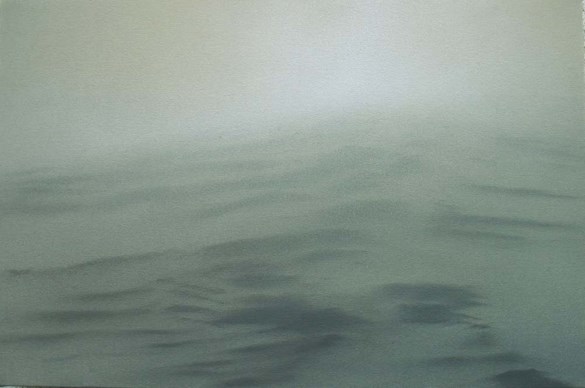
Passare al Bosco, 2015, acrylic on canvas, 33 x 50 cm
AD: What are you working on at the moment?
MS: Right now I am retracing my journey to build a catalog that will contain most of my work and those who have accompanied me over many years, with important texts and exhibitions. After that I will continue to work on projects between Italy, Carinthia and Portugal.
AD: Has your work been impacted by the coronavirus?
MS: No. Mine is not a didactic work or a work that takes its cue from various events. If emotionally something inside me has moved, it is because I intensely live all the events that come into my life, and therefore many things can change, but the coronavirus as a subject does not interest me. I do not forget countries that are also experiencing other conflicts, other absurd deaths. Of course this intruder is spread in the same way all over the world. It is a virus that does not discriminate, which makes us all equal. Is it teaching anything? But all the rest: immigrants, starving children in Syria, Africa, wars ... there is no mention of all the huge world misfortunes, but daily numbers are broadcast that are not even real. Where is everything else?
However, I make this statement in compliance with the current preventive rules that have been asked of us, but in this new situation, what worries me most is not the virus itself but the alteration it is producing in people. I believe this is what will enter my work the most, I believe I will continue to be in the deserts, where you cannot lie in solitude with yourself. And this thought is what drives me to deepen my identity as an artist. I recommend reading Ernst Junger: "The treatise of the rebel", a socio-political essay written in 1951, but incredibly current. We must not forget ourselves in any situation.
AD: Can you name a contemporary Italian artist who inspires you?
MS: All contemporary and modern art is part of my life, with artists that I love most, that I absolutely don't love, or that leave me indifferent. Someone who, on the other hand, is of great inspiration to me at the moment (I'm sorry, but we have to get out of Italy) is Fernando Pessoa. I think he will enter my work soon, but I have always felt like a writer and not a painter, even if I use it to write a brush.
AD: When did you first begin to think of yourself as an artist?
MS: There is no when, I don't know if it's like that. There are various stages of maturity or commitment to recognize one's autonomy, but there has been no starting point. I would say that I was born with a certain strong emotion that led me to express myself in a certain way. I do not recognize origin and I imagine that there will not even be an end. Being an artist does not necessarily imply obtaining a product, you are an artist even at a glance. I hope my last look at the world will remain an artist's gaze.

ArtDependence Magazine is an international magazine covering all spheres of contemporary art, as well as modern and classical art.
ArtDependence features the latest art news, highlighting interviews with today’s most influential artists, galleries, curators, collectors, fair directors and individuals at the axis of the arts.
The magazine also covers series of articles and reviews on critical art events, new publications and other foremost happenings in the art world.
If you would like to submit events or editorial content to ArtDependence Magazine, please feel free to reach the magazine via the contact page.